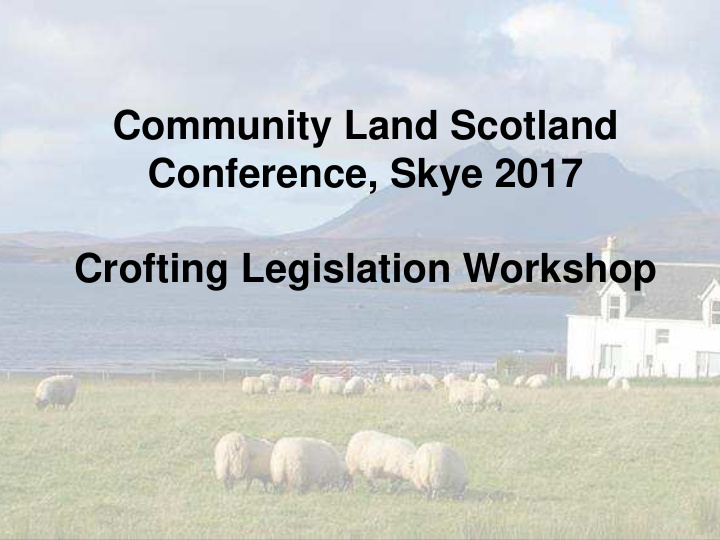



Community Land Scotland Conference, Skye 2017 Crofting Legislation Workshop
Purpose: to establish the opinions, perspectives and experiences of those involved in crofting in some capacity, the aim of which is to provide a basis upon which to build our later outputs. Who we’ve spoken to: various organisations and people (crofters, NFUS, SLE, SCF, CC, landowners, local council members, young crofters) Where we’ve gone : Shetland, Eilean Siar, Inverness, Lochcarron, Invermoriston
What are the aims and purpose of crofting, and what should it hope to achieve? What are the current assets and future opportunities that will allow those involved in crofting to achieve these aims? What are some of the barriers that prevent or hinder the gaining of these aims?
1) the aims and purpose.. Stable and flourishing local communities that actively co- … what it should achieve operate and engage • Increasing the number of young Thriving and resilient rural people and new entrants to crofting economies that link to local / • Local direct / indirect employment national / international market places • and consumers Producing high-quality, in demand, locally sourced livestock, crops and produce Maintained and balanced land and • Sustainable habitat and species ecosystems that encourage tourism management and biodiversity • Multiple, diverse and innovative land uses Fair and equitable relations • Sharing knowledge and good practice between all crofting stakeholders • Secure residence • Profitability and a fair standard of living • Access to appropriate financial support and incentives • Tourism
2) What are the current assets … Skilled, hard-working people with intimate and historic … the future opportunities knowledge of the land and a passion for crofting • Incentivise and remove barriers to young Young persons and new persons entering crofting entrants to crofting • Further diversify land uses and outputs Resilient land, environment and • Encourage and support co-operation wildlife between crofters (e.g. common grazings, Unique produce and brands sheep stock clubs, dissemination of knowledge and skills, resolution of local Tourism disputes) Collective action in stock clubs, • Expand use of renewable energies and common grazings, and grazing environmentally beneficial processes (e.g. committees wind, carbon capture) Support from grants and • Simplify and clarify current legislation and subsidies devolve power • Make CC more open and responsive (devolved?)
3) What are some of the barriers ? Rural and Island: Restricted technological infrastructure (e.g. broadband internet, mobile reception) Distance to markets and additional costs of production Higher cost of living Out-migration Access to land Lack of skills and knowledge sharing Agricultural: Poor quality land Reducing levels of financial support Uncertainty over EU Reducing returns form historical forms of agriculture (e.g. sheep and beef) Climate change
3) What are some of the barriers ? Cultural: • Lack of young persons entering crofting • Regional variations in definition of ‘crofting’ • Absenteeism and land management • ‘Us’ versus ‘them’ attitudes towards crofting • Clashes and disputes between personalities • Romanticism of crofting ‘way of life’ • Inheritance of land • No clear SG policy or narrative on crofting Legal: • Piecemeal nature of legislation is overly complex and restrictive • Lack of security of tenure • Definitions of ‘owner - occupier’ are unhelpful, lacks clarity • SUMP benefits lawyers not crofters • New / young crofters being blocked by lack of support from banks and succession / inheritance laws • CC too bureaucratic, distant and opaque
Thank you Contact: Neil.Davidson@gov.scot Michael.O’Neill@gov.scot
Recommend
More recommend